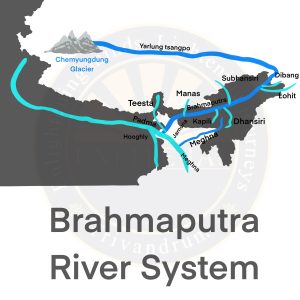Basics
- Origin: Chemayungdung glacier in Tibet, China.
- It flows as the Yarlung Tsangpo River across southern Tibet to break through the Himalayas in great gorges and into Arunachal Pradesh where it is known as Dihang.
- The first major tributary is the Raga Tsangpo meeting the Tsangpo near Lhatse Dzong.
- West of the town of Sadiya, the Dihang turns to the southwest and is joined by two mountain streams, the Lohit, and the Dibang, and below the confluence, the river is known as the Brahmaputra.
- It flows through Bangladesh as the Jamuna where it merges with the Ganga (Padma) to form a vast delta, the Sunderbans.
- The biggest and the smallest riverine islands in the world, Majuli, and Umananda respectively, are situated in the river in the state of Assam.

Left Bank Tributaries of Brahmaputra River
- Dhansiri River
- It originates from the Naga Hills in Nagaland.
- Lohit River
- The River Lohit originates in eastern Tibet.
- The river flows through the Mishmi hills to meet the Siang at the head of the Brahmaputra valley.
- Dibang River
- Originates close to the Tibetan border at an altitude of more than 5000 m.
- The Mishmi hills are found along the upper course of the Dibang River.
Right Bank Tributaries of Brahmaputra River
- Subansiri River
- Also called the Gold River as it is famous for its gold dust.
- Flows through Arunachal Pradesh and is ideal for kayaking.
- Kameng River
- Kameng River in the eastern Himalayan mountains originates in the Tawang district of Arunachal Pradesh.
- The Pakhui Wildlife Sanctuary and the Kaziranga National Park are located near the Kameng River.
- Manas River
- Manas River is a transboundary river in the Himalayan foothills between southern Bhutan and India.
- It flows through Royal Manas National Park in Bhutan and its contiguous Manas Wildlife Sanctuary in India.
